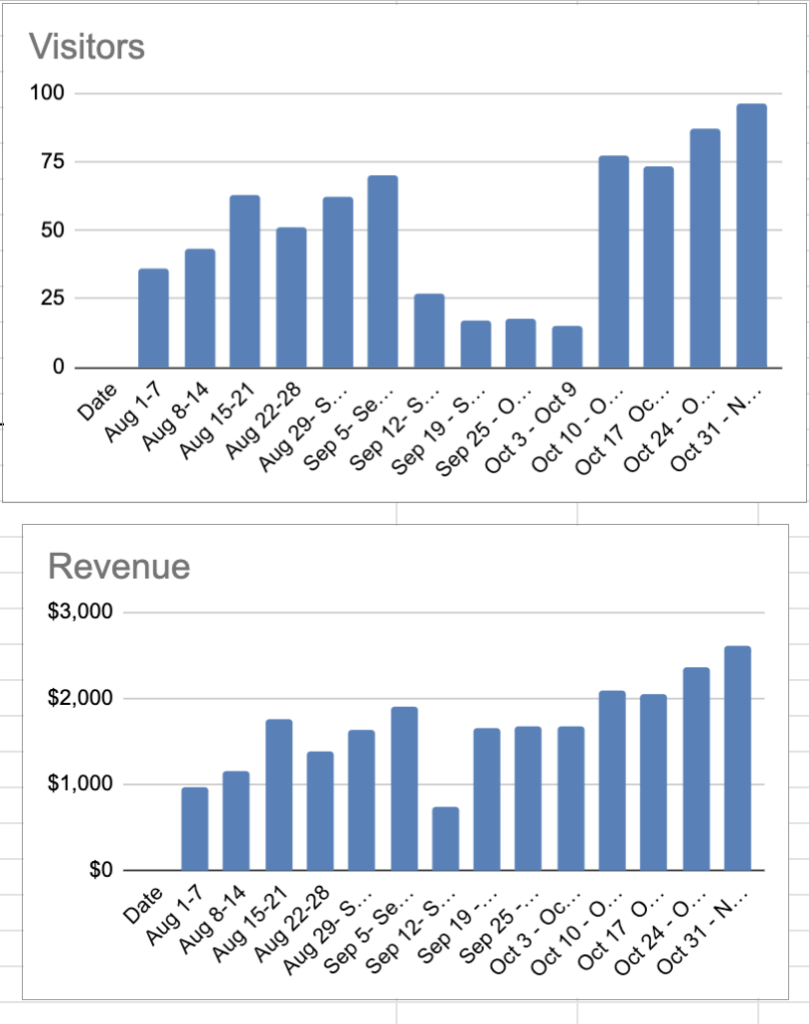Things have been going well the last couple weeks. Here’s a few updates.
I hired a second employee, Christina. She’s the co-worker and roommate of the first employee, Chelsea. They both have a lot of experience doing this sort of work and since they know each other that will hopefully help us co-ordinate what is a somewhat unpredictable schedule of visitors. Also they are both great, so I’m super excited about that.
Visitors and Revenue
It seems that Saturday is the most popular day, followed by Friday, then Thursday, and then possibly Wednesday. I have no idea why Sunday tends to be pretty slow. Last week Saturday was pretty full and then Sunday just one showing.
We’ve been getting lots more weekday bookings than I had imagined. Much of it is people staying nearby or at a convention or something downtown. Probably about 75% of visitors during the week are out-of-towners. Here’s a couple charts showing growth through last Sunday:

The dip in visitors is that period when I had burned myself out and had to block out loads of bookings. Once I hired Chelsea and re-opened bookings it jumped right back up.
Last week was our best with visitors with 96. As of 7pm Thursday night we already have 108 visitors booked this week, so it’s looking like another record week for the room. Booking revenue follows a similar trend but even more increased because people are booking future dates.
I’ve had a lot of 8+ groups contact me lately. Probably because I improved the page for 8+’s copy. It was pretty negative before. Now it’s way more enticing and I’m getting lots of bigger groups. There’s a lot of 9-12 groups on the schedule now.
Promotion Efforts
I continued to struggle with the tracking for google ads. I finally decided to post an ad on upwork.com to get help. A couple people on there gave me some free advice and I tried that. It seems to sort of work. I tested it 3 times with me and 2 others and it registered the sale. But the last 5 days has only registered one more sale. If google ads is throwing money in a hole, I’m throwing money in a hole while being in the dark. I spent $400 last week on ads and have no idea if it helped. I can check the comments in the “how did you hear about us” section of the purchases. Throwing out known non-google sources I can get an upper bound of return. Throwing out additional responses like “internet” and “google” gives me a lower bound. Even the best case scenario is still pretty terrible.
The Austin City Guide site is doing fairly well. I’m getting a 60% discontinuation rate once they hit the home page. I think if I make a landing page that speaks to those people I can get a chunk of those people to convert.
Free options like Reddit, AustinTexas.org, and word of mouth are doing well. Word of mouth seems to be the #1 way people get there, which is great.
Misc
The list of things I could potentially do on any given day is enormous. It seems that my main job is to just figure out the most important thing I can do for the room at any given moment. Everything from coat rack to new programs to better shirts to fixing programs or curtains or better benches. Updating the website, finding other places to promote, catching up on the books, taking a break. There’s so many options. I probably spend 30-60 minutes each day just narrowing down what will have the biggest ROI.
Funding
I’ve been setting aside time to work on a short 3-4 page document to show to potential sources of funding. While it’s very likely I could bootstrap the company, I think that is going to be a slow and more laborious road filled with me doing lots of things that are best left to someone else. But the main reason is that I don’t want opportunity to come up for a new location and it be too far out of my financial reach or comfort zone. Great fits don’t come along too often for the Room and I want to make sure I’m prepared for them when they appear.